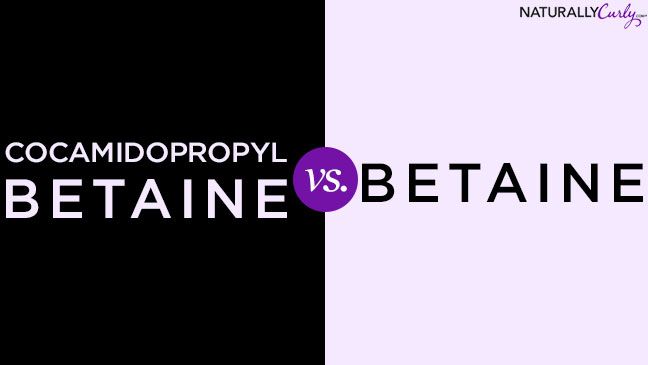Oftentimes ingredients in hair care products have very similar names, which makes it natural to assume that they have comparable properties and functions in the product. This is frequently a reasonable and reliable assumption. For example, although sodium lauryl sulfate and sodium laureth sulfate have a distinct structural difference that alters their specific properties, they are still sufficiently alike that one could be assured they are both surfactants/detergents. At other times, ingredients sound the same, but are profoundly different, and it is important to have a good understanding of the similarities and differences in these particular instances. Two ingredients for which this is true are betaine and cocamidopropyl betaine (CAB”>. While both betaine and CAB may be found in either shampoos or conditioners, they have different functions and perform entirely different. The differences in chemical structure explain the differences in properties and can help clarify this confusing family of ingredients.
Cocamidopropyl Betaine
Cocamidopropyl betaine is a popular synthetic surfactant used as an emulsifier, cleansing agent, and foam booster in many hair products. CAB is a zwitterionic molecule, possessing both a positive and a negative charge, which create a polar, hydrophilic head group to the molecule. It has a hydrophobic tail, made up of a linear hydrocarbon chain that is usually 12 carbons in length. This gives the molecule a dual-nature that is responsible for its surfactant properties, enabling it to modify the surface and interfacial tension in aqueous solutions.
Cocamidopropyl betaine is a popular synthetic surfactant used as an emulsifier, cleansing agent, and foam booster in many hair products.
It is favored by formulating chemists, as it is stable at a wide range of pH values and is compatible with many ingredients, including all of the usual surfactants. CAB can effectively remove most dirt, oils, and silicones from the surface of the hair. It is gentler and less irritating than surfactants such as sodium lauryl sulfate, but it can still be fairly drying to the hair, especially if it is included at high concentrations or is not accompanied by replenishing moisturizing agents and emollients.
Betaine
Betaine is a moisturizing agent, but not a surfactant so it has no cleansing properties.
Betaine is found in hair conditioners and also in shampoos. It is a naturally-occurring amino acid (trimethylglycine”> obtained as a by-product of sugar beet molasses. It is a water soluble, hygroscopic molecule that belongs to an interesting category of compounds known as organic osmolytes. Due to their strong affinity for water, osmolytes are materials that affect osmosis, the definition of which should be etched permanently upon our memories from middle school biology: “the diffusion of water through a semi-permeable membrane”. Their humectant properties and their ability to accumulate in and around cellular interfaces permit these species to participate in cellular processes by helping maintain optimal fluid balance. Another important function of osmolytes is their role in stabilizing protein structures. By direct interaction with the polypeptide backbone of the protein, the osmolytes are able to maintain the preferred equilibrium state of the folded structure of the protein. In doing so, they disrupt destructive processes that would result in an unfolded protein conformation. This is very important for both hair and skin (and all specialized cells”>, because protein function is absolutely dependent upon this tertiary structure of the protein (folded versus unfolded”>.
When included in a hair conditioner, one role of betaine is to act as a moisturizing agent or humectant. One study showed that water retention in hair was improved by 6% when glycerol (glycerin”> was used, while a 40% increase was observed for betaine. Also, as a result of their direct interaction with the proteins in hair, betaine can improve the mechanical properties, such as strength and elasticity. Betaine improves shine by helping maintain the integrity of the cuticle surface. As an osmolyte, it also possesses the ability to penetrate the stratum corneum of the scalp, where it can optimize moisture in the skin cells and follicles, positively impacting the health of the scalp and contributing to healthier hair. Finally, betaine acts as a guardian for the structure of the keratin proteins in the hair, both in the cuticle and the cortex, and protects it from damage due to environmental causes.
While it is many things, betaine is not a surfactant, so it has no cleansing properties. It can enhance the texture and height of foam, so it may be added to shampoo formulas for that reason, in addition to its moisturizing and protective properties. But if it is in a conditioner that you wish to use as a gentle cleanser, it cannot provide that service.
Take-home message
With their similar names, it can be confusing as to what the roles of betaine and cocamidopropyl betaine are in shampoos and conditioners. Since they are structurally very different, each one imparts unique properties to products in which they are present. Betaine is a naturally-obtained, high-performance additive for hair conditioners, useful for its moisturizing and structural protection abilities. It is not a surfactant or cleansing agent, but it is a humectant and protein protectant. Cocamidopropyl betaine is a synthetic surfactant, useful for cleansing the hair. Both ingredients are great to have in products for their own specific contributions, but it is great to know what each one is doing for your hair.

